We’ve entered an era where bare manicures are more popular than ever. So it might seem a bit contradictory that press-on nails are trending too—one quick TikTok search proves just how much people love them. But actually, the two go hand-in-hand (pun very much intended).
For those of us embracing naked nails, press-ons offer the perfect alternative whenever the moment calls for a polished look (just ask Suni Lee). They require less of a time commitment—for both application and wear—compared to gel manicures. And many people are also turning to press-ons to avoid the UV light required for gels, Mazz Hanna, a celebrity manicurist and CEO of Nailing Hollywood, tells SELF.
But that doesn’t necessarily mean that these temporary falsies don’t come with their own potential pitfalls. Here, experts explain the pros and cons of press-on nails—and share the best ways to minimize damage.
Are press-on nails bad for your nails?
Let’s start with some good news: “There’s nothing inherently bad about press-on nails and you don’t have to swear them off,” Omer Ibrahim, MD, a board-certified dermatologist in Chicago, tells SELF. “The issues arise from improper application and/or removal,” Dr. Ibrahim explains. As long as you take the proper steps (see below), it’s totally fine to continue incorporating them in your manicure routine.
On the other, heh, hand, if you do things the wrong way, you’re definitely putting your natural nails at risk. When it comes to application, one of the most common problems is sticking the falsies on too tightly, notes Dr. Ibrahim. This puts excessive pressure on the natural nail underneath, which can cause surface indentations and may even injure your nail matrix, the area where new growth occurs, he explains. Ridges and dents—while maybe not the cutest—aren’t the end of the world and “usually disappear over three to six months, once the nail grows out,” he says. But damage to your matrix can stick around longer, and may ultimately cause your nails to grow out thinner or more slowly, he adds.
However, all of the experts we spoke with agree that improper removal (specifically overzealous pulling) is the most common culprit for press-on damage. The nail plate is made up of three different layers. If you rip off fake nails, you can end up taking off chunks of the outermost layer, Dr. Ibrahim says. The result? Everything from bumps and ridges to thinning to increased peeling to discoloration.
Dr. Ibrahim notes that he often sees people with white streaks or patches on their nails; the condition is called leukonychia and can show up when press-ons or gel manicures damage the keratin in the nail plate. The good news: While you may not like how this discoloration looks, it doesn’t cause any permanent problems and usually resolves on its own after a few months.
Another rare but real risk: If your press-ons are really stuck and you aggressively try to pull them off, you might even lift up the lowest layer of your nail plate, where your nail attaches to the skin underneath, Hadley King, MD, a board-certified dermatologist in New York City, tells SELF. It’s unlikely, especially if you’re being careful, but it is possible—and can be very painful and may even cause an infection. (Moisture and, subsequently, bacteria can accumulate in the space between the nail and skin, Dr. King explains.)


